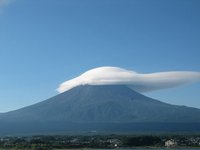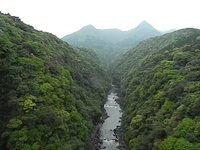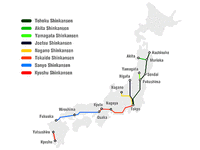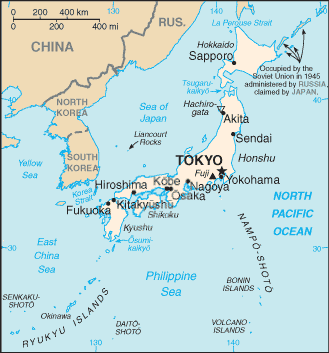Japan
Travel Guide Asia Japan
Introduction
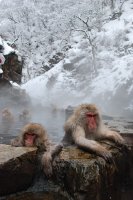
DSC_0312
© HT
Japan (日本), located in the northwest Pacific, is a nation comprised of four main islands and several thousands of smaller islands, including the Ryukyu Islands to the south of the mainland.
Modern Japan struggles with an interesting tension between highly sophisticated Westernization and traditional values. In Tokyo, elements of the past are almost but not entirely submerged by the city's striking modernity. Kyoto presents traditional architecture more successfully, owing to its role as Japan's cultural centre.
With a population of almost 130 million, population density is high and makes use of available land for housing, commerce and farming. This can result in conflicts about land use where people and infrastructure take precedence over natural considerations. However, there are many preserved and relatively untouched areas of outstanding natural beauty. A more substantial challenge to the country as a whole is its declining population and this feature is likely to dominate its future in the coming decades.
Brief History
Main article: History of Japan
Early Japan
Japan has a very long and complicated history. The first signs of people living in the Japanese Islands appeared with stone age cultures at around 30,000 BC. This continued for about six thousand years when the Jōmon period began, a mesolithic to neolithic semi sedentary-hunter-gather culture. In the third century BC the Yayoi period began, which was a major shift in Japanese culture. During the Yayoi period wet-rice farming, iron and bronze making and more advance pottery appeared in Japan most likely from migrant from China or Korea.
Classical Japan
Classical Japan starts when Buddhism was first introduced to Japan from Korea there was limited resistance. Although by the Asuka period (538 AD to 710) it gained general acceptance. During Nara Period (710 AD to 794) was when the first strong central Japanese state emerged. Their imperial court was the modern day city of Nara. Although not the first capital it was the first centralized state and the government borrowed heavily from Chinese administrative practices. In 784 the Emperor Kammu relocated the capital to present day Kyoto which it stayed for more then a thousand years.
Feudal Japan
After the classical period came feudal Japan, which is best represented by the samurai. The samurai were a warrior class that were tied to specific house and went under intense training. The samurai slowly came to power over the period of several hundred years as the central government took less and less interest in the military. The government would employ the different houses at first, then the different samurai houses learned to work together to take control of the government. The samurai class came to full power during the Kamakura period (1185 to 1333). After the Kamakura shogunate fell several other powers rose and fell quickly, which eventually lead to a century long civil war in 1467. During the 16th century traders and Jesuit missionaries, primarily from Portugal, starting to make contact with Japan. In 1639 the Tokugawa Shogunate came to power in present day Tokyo and immediately close the country to foreigners, which last for over 250 years.
Western Contact and Modernisation
On March 31, 1854 this all changed when Commodore Matthew Perry and his coal powered ships steamed into Tokyo and forced open Japan with the Convention of Kanagawa, which started Imperial Japan. After Commodore Perry arrived in Japan some of the leaders of Japan knew they had to change if they wanted to remain in power. Many of the lesser samurai instilled a movement to move power back to the emperor again. Many samurai resisted most of the new laws, which included removing the special status of the samurai, which led to the Bosin war (1868 to 1869). This is when the samurai were slaughtered by a modern army.
The Meiji Restoration led to a massive westernization of Japan and resulting in a very quick industrialization process. Japan went from a feudal farming society to an industrial power house with a modern army in under 20 years. Militarization and expansionism where the made motives behind Imperial Japan in the first half of the 20th century, which included a war with Russia. In 1931 Japan occupied Manchuria which was very unpopular around the world. In 1936, Japan signed the Anti-Comintern Pact with Nazi Germany and eventually joined the other Axis powers in 1941. On December 7, 1941 the Japanese bombed the United States naval base in Pearl Harbor, which brought the United States into the war. After a countless long and bloody battles the war ended with the United States dropping two atomic bombs, one on Hiroshima and the other on Nagasaki. After this the Imperial government was forced to sign an unconditional surrender on August 15, 1945.
Post-War Japan
Japan was in ruins after the war physically, culturally and emotionally. Every single city had been bombed into dust and no one knew what to believe in. The occupying powers forced the Japanese to adopt a pacifist constitution in 1947 which has never been changed. This pushed forward a modern democracy. The United States fearing the spread of communism quickly rebuilt the country and instilled new leaders. The Allied occupation of Japan ended in 1952 with the signing of the Treaty of San Francisco. Over the next four decades Japan experienced amazing economic growth at an annual rate of 10% every year. In the mid 1990s Japan suffered from a major recession. In recent years the economy has been slowly growing again.
On March 11, 2011, Japan suffered the strongest earthquake in its recorded history, affecting the northeast area of Honshu. The magnitude 9.0 quake was aggravated by a tsunami and also caused numerous fires and damaged several nuclear reactors. Thousands of people lost their lives and many more are still missing.
Geography
Japan's territory is 377,923.1 km², of which 374,834 km² is land and 3,091 km² water. Japan is made up of 4 main islands (Honshū, Hokkaidō, Shikoku and Kyūshū), the Ryukyu Islands, Okinawa and many other islands. Japan has a total of 6,852 islands extending along the Pacific coast of East Asia stretching down to Taiwan bordering the western Pacific Ocean. The country, including all of the islands it controls, lies between latitudes 24° and 46°N, and longitudes 122° and 146°E. They are separated from the mainland by the Sea of Japan, which historically served as a protective barrier. Up to 80% of Japan's land is forested, mountainous (with the highest mountain, Mt. Fuji, rising to 3,776 metres above sea level) and unsuitable for residential, agricultural or industrial use. This has led to a high population density in the habitable areas.
Japan is located on the so called Pacific Ring of Fire, at the juncture of three tectonic plates. This means Japan frequently experiences tremors and occasionally volcanic activity and destructive earthquakes. Recent major quakes include the 2004 Chūetsu earthquake and the Great Hanshin, or Kobe Earthquake of 1995. Typhoons are other natural disasters that frequently hit the country.
Regions
Japan has 47 prefectures (to-dō-fu-ken). These prefectures are commonly grouped into the following eight regions, which are listed below from north to south. The regions of Japan are not official administrative units, but have been traditionally used as the regional division of Japan in a number of contexts. For instance, maps and geography textbooks divide Japan into the eight regions, weather reports usually give the weather by region, and many businesses and institutions use their home region as part of their name. Note that the region of Hokkaido is also the prefecture and thus is the largest prefecture in Japan.
- Hokkaidō, Japan's second largest and northernmost island, is known for its dramatic peaks, gorges and lakes. The largest city is Sapporo. Hokkaido is the only region that consists of only one prefecture called by the same name: Hokkai-dō;
- Tohoku, in northern Honshu, is a scenic rugged area. The most major city is Sendai. Tohoku consists of six prefectures: Aomori-ken, Akita-ken, Iwate-ken, Yamagata-ken, Miyagi-ken and Fukushima-ken;
- Kantō, in eastern Honshu, is the most urban and developed part of Japan, home to the Tokyo metropolis and the city of Yokohama. Kanto consists of seven prefectures: Tochigi-ken, Gunma-ken, Ibaraki-ken, Saitama-ken, Tōkyō-to, Chiba-ken and Kanagawa-ken;
- Chūbu, in central Honshu, to the west of Tokyo is divided by the Japanese Alps and includes iconic Mount Fuji. The Chubu region is also sometimes subdivided into the Hokuriku region (main city: Kanazawa), the Koshinetsu region (main city: Niigata) and the Tokai region (main city: Nagoya). Chubu consists of nine prefectures: Niigata-ken, Nagano-ken, Yamanashi-ken, Shizuoka-ken, Tōyama-ken, Gifu-ken, Aichi-ken, Ishikawa-ken and Fukui-ken;
- Kansai (or Kinki), in southwestern Honshu, is the cultural and historical heart of Japan and home to the major cities of Osaka, Kyoto and Kobe. Kansai consists of seven prefectures: Shiga-ken, Mie-ken, Kyōto-fu, Nara-ken, Ōsaka-fu, Wakayama-ken and Hyōgo-ken;
- Chūgoku, the westernmost region in Honshu, includes the cities of Hiroshima and Okayama. Chugoku consists of five prefectures: Tottori-ken, Okayama-ken, Shimane-ken, Hiroshima-ken and Yamaguchi-ken;
- Shikoku is the smallest of Japan's four islands and the main city is Matsuyama. Shikoku consists of four prefectures: Kagawa-ken, Tokushima-ken, Ehime-ken and Kōchi-ken;
- Kyūshū is Japan's third largest main island and the most southern with the main city being Fukuoka. The region also covers the Ryukyu Islands, including the main island, Okinawa. Kyushu consists of eight prefectures: Oita-ken, Fukuoka-ken, Saga-ken, Nagasaki-ken, Kumamoto-ken, Miyazaki-ken, Kagoshima-ken and Okinawa-ken.
Cities
- Fukuoka, in Kyushu, is the gateway to southern Japan and one of the country's major trading ports.
- Hiroshima is famous for all the wrong reasons. Millions of visitors are drawn to the city each year to consider first-hand the impact that the dropping of the world's first atomic bomb has had.
- Himeji located one hour west of Osaka and home to the world famous Himeji castle.
- Kanazawa, in Central Honshu, is a city with a rich cultural heritage and the sights to prove it.
- Kobe is famous for Kobe beef, a lively nightlife and the massive 1995 earthquake that destroyed over 100,000 buildings and killed over 5,000 inhabitants.
- Kyoto, the old imperial capital, is famous for its kimonos, numerous temples and preserved monuments.
- Nagano is best known as the host city of the 1998 Olympic Winter Games, but has great scenery and hikes still.
- Nagasaki suffered the second atomic bomb in World War II. Since then it has developed as one of Japan's most cosmopolitan and eclectic cities.
- Nagoya is the 4th largest urban area in Japan (called the Chukyo Metropolitan Area) and even the 3rd largest if counting the city proper only. It's relatively overlooked by (international) travellers.
- Osaka is Japan's third largest city.
- Sapporo is the capital of Hokkaido, Japan's second largest island.
- Sendai is the largest city in Northern Honshu.
- Tokyo, the sprawling capital of the country, is a modern, exciting metropolis that leaves its visitors awe-struck.
- Yokohama is Japan's second largest city and the country's largest port.
Sights and Activities
Daisetsuzan National Park
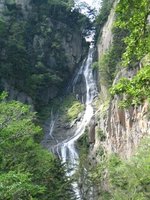
Shooting Stars Waterfall
© qelow
The Daisetsuzan National Park is located in the central part of Hokkaido and is one of the natural highlights of the country. The name means 'Great Snowy Mountains', which is true for a large part of the year; from October to May, the park or at least the higher parts are covered in snow. It's the largest national park in Japan and an absolute must for anyone wanting to do some serious hiking. The park has 15 mountains which are over 2,000 metres high and hikes range from easy strolls of several hours to challenging multi-day hikes. The highest point is the Asahi Dake at almost 2,300 metres. The main gateway to the park is at Asahikawa, which can be reached by train. Other points of entry include Furano and Rubeshibe, both also excessed by train. From there you need to catch a bus or rent a car. Entrance to the park and most parking is free. After hiking, a great reward is a visit to the famous Sounkyo Onsen (hot springs).
Himeji Castle
Himeji Castle (or Himeji-jo) is the best preserved castle in Japan and a must see for all tourists. Located one hour west of Osaka, it is a beautiful day trip for any visitor to the Kansai area. Himeji Castle, also known as the White Heron Castle, was designated as a UNESCO cultural site in 1993.
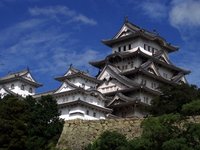
Himeji Castle
© AKISSA
The interior of the castle was restored in the traditional manner with wood, not concrete and is the greatest look into medieval Japanese castle construction. The castle also provides an excellent look into life of Japanese nobility in the 16th century. Himeji Castle was first built in 1346 by Akamatsu Sadanori. It was built as a defence against the local Shogunate. This fortification was eventually rebuilt in 1580, Toyotomi Hideyoshi, into the structure that is seen today. Himeji Castle was never attacked or used in battle. As well, it was not damaged during WWII. It was finally restored in the 1960s.
Kyoto
If you only visit one city in Japan, be sure to make it Kyoto. Japan's capital until it was moved to Tokyo in 1868, Kyoto is considered by many to be Japan's most beautiful city. Only Rome lays claim to more designated Unesco World Heritage Sites than this city nestled amongst the mountains of Western Honshu.
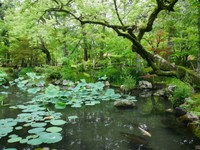
Eikan-do garden
© Peter
The magnificent array of temples and shrines include famous names like the Golden Pavilion, Kinkakuji and the Ryoanji zen garden. Kyoto is a sightseers paradise and much can be taken in on foot, although don't expect it to be the first impression you get of the city on arrival. Urban sprawl and ultra modern buildings like the glass and steel main train station, show signs of a city embracing modern times despite it's deeply traditional roots. But once you do find yourself in areas like Old Kyoto wandering down alleys of traditional narrow, wooden houses you will learn to appreciate the great artistic heritage that defined Kyoto for over a thousand years.
Mount Fuji
Mount Fuji is one of the best known natural features of Japan and is conveniently located west of the capital Tokyo. Mount Fuji has an exceptionally symmetrical cone which is a recognisable symbol of this East Asian country. Over 200,000 people climb the mountain yearly and most of them climb from July to August when huts and most other facilities in and around the mountain and nearby villages are open. It is part of the Fuji-Hakone-Izu National Park and although it hasn't erupted for about 300 years, it is indeed a volcano.
It also is surrounded by five lakes, among which are Lake Kawaguchi, Lake Yamanaka and Lake Motosu. From these lakes and Lake Ashi (which is a little further away) people who do not want to climb the mountain can have excellent views of the mountain when the weather is clear. In winter, the summit is covered in snow.
Onsen (Hot spring Bath)
The onsen, or hot spring bath, can be found at many hotels in rural areas throughout the country where mountain hot springs provide a natural version. One enters the onsen, gets naked and then squats on a stool. You soap up and rinse off using a bucket of water and a washcloth; now that you're clean, you enter the bath itself, which is full of really hot water. It's a relaxing and liberating experience, and apparently one of the few places in Japanese society where you are free of rules. Most hot springs are separated by sex, with men and women having their own separate hot spring, but some are co-ed. As well, most onsen do not permit people with tattoos to enter.
Pachinko
Pachinko is a form of Japanese gambling where you turn a little silver knob, which shoots BBs out of the top of the machine. If you turn the knob too far to the right, the BBs run all the way down and out the one side. If you don't turn far enough, the BBs don't make it to the center of the machine, and fall down the other. If you hold the knob just right, though, the BBs will bounce off some nails, and if you are lucky, fall into a small slot where you will win 5 more BBs. If you win, you take your BBs and exchange them for money outside of the pachinko parlor (due to gambling restrictions).
Sento (Public Bath)
Sento, or public bath, is available at many places in the city. A few hostels or inns do not provide a shower nor a bath room and suggest that their guests take a bath at the nearby sento. It seems that local people go to the sento for a relaxing experience. The procedure is the same as in onsen, where you get naked and cleanse your body before entering the bath itself.
Shirakami-Sanchi
Shirakami-Sanchi (白神山地?, literally white god mountain area) is a UNESCO World Heritage Site in northern Honshu. This mountainous, unspoiled expanse of virgin forest straddles both Akita and Aomori Prefectures. Of the entire 1,300 km², a tract covering 169.7 km² was included in the list of World Heritage Sites in 1993. Siebold's beech trees make up a large portion of the forest. The World Heritage Site area has never been opened to human activity or trails other than mountain climbers' paths, and is planned to be protected in this state. Permission is needed from Forest Management to enter the heart of the Shirakami-Sanchi. Fishing requires permission from both the Fishing Cooperative and Forest Management.
Shiretoko National Park
Shiretoko National Park covers most of the Shiretoko Peninsula at the northeastern tip of the island of Hokkaido. The word "Shiretoko" is derived from an Ainu word "sir etok", meaning "the place where the earth protrudes". One of the most remote regions in all of Japan, much of the peninsula is only accessible on foot or by boat. The park is best known as the home of Japan's largest brown bear population and for offering views of Kunashiri Island, ownership of which Japan and Russia dispute. The park has a hot springs waterfall called Kamuiwakka Falls. Kamui wakka means "water of the gods" in Ainu. The forests of the park are temperate and subalpine mixed forests; the main tree species include Sakhalin fir, Erman's birch and Mongolian oak. Beyond the forest limit there are impenetrable Siberian Dwarf Pine (Pinus pumila) thickets. In 2005, UNESCO designated the area a World Heritage Site, advising to develop the property jointly with Kuril Islands of Russia as a transboundary "World Heritage Peace Park".
Skiing
In recent years skiing has become a very popular activity for the Japanese. Japan has some very good skiing with excellent vertical. One of the nice parts about skiing in Japan, when compared to the United States or Europe, is that it is not that expensive. For a country where everything is very expensive, skiing actually gives you good value for your yen.
- Hakuba - a ski village at the foot of Japan Alps, about five hours by bus from Tokyo near the city of Nagano.
- Niseko - made up of 5 different ski resorts, Annupuri, Higashiyama, Hirafu, Hanazono and Moiwa, on the island of Hokkaido. These resorts have some of the best snow in the country and a more relaxed attitude to out-of-bounds skiing.
- Rusutsu - located about 90 minutes away from Sapporo's Chitose International Airport. It has some of the best tree skiing in Japan.
- Other Japan ski towns - Guides for many of the popular ski towns in Japan.
Sumo
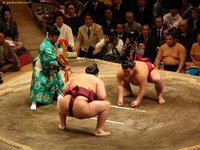
Sumo wrestling
© gard
Sumo is one of the main sports in Japan and something of a way of life. The sumo wrestlers are adored and are treated as gods. The two large men face each other, slapping themselves to get the blood flowing in preparation for the impending fight. One of the men squats down and puts his fists against the ground. The other man follows suit, and as soon all four fists are on the ground, the two men spring back up and lunge at each other. They grunt and groan as they grapple with each other, struggling to either push the other man out of the ring or throw him to the ground. There are six grand sumo tournaments, or basho, held throughout the year in Japan.
Yakushima
Yakushima is one of the Ōsumi Islands belonging to Kagoshima Prefecture. Yakushima's unique remnant of warm/temperate ancient forest has been a natural World Heritage Site since 1993. In the Wilderness core area (12.19 square kilometres ) of the World Heritage Site, no record of past tree cutting can be traced. Yakushima is located approximately 61.3 kilometres south of the southern tip of Osumi Peninsula in southern Kyushu, or 135 kilometres south of Kagoshima. The Vincennes Strait (Yakushima Kaikyō) separates it from the nearby island of Tanegashima, which is home to the Japanese Space Centre.
Other Sights and Activities
- Geisha - a female entertainer trained in the traditional arts of Japan (singing, poetry, dance, tea ceremony, etc.). The best place to spot these ghostly beauties is in the back alleys of Kyoto.
- Meiji-jingu - a wonderful park and garden in the centre of Tokyo. The main entrance to the park is a good place to stop if you want to spot the new trends in Japanese youth fashion and goth.
- Nijo-jo - castle built in 1603 for the first Tokugawa shogun in Kyoto. This is the only home in the world where creaky floors were built on purpose as warning system against possible assassins. There are also several nice gardens.
- Ogasawara-shotō - The Ogasawara (or Bonin) Islands are located about 25 hours by ferry exactly south of Tokyo. The main island is Chichi-jima and the other inhabited island is Haha-jima. Few westerners come here, but it's a rewarding trip to Japan's (sub)tropical region between the main islands and Guam.
Events and Festivals
Traditional Festivals
Japan has countless traditional festivals and holidays. Then when you add the local festivals that number just grows and grows. Here is a list of the few major national traditional festivals.
- Japanese New Year (January 1) - the most important holiday in Japan. Although there are lots of customs and traditions most of them are done in the private. This is mainly a family holiday and Japan can feel very empty as almost everyone goes home. Travelling in Japan in during this time is difficult because everything is shut down.
- Seijin No Hi (2nd Monday of January) - the coming of age holiday for Japanese women which 20. Traditionally families will buy any young woman how turned 20 in the last year a kimono. On this day almost all Japanese women will ear a kimono.
- Hin Festival (March 3) - Also known as doll festival the Hin Matsuri festival is meant for young women. In early february families with daughters put dolls in order to make the women happy and healthy later in life. On Girls Day, on March 3, the dolls are put away until next year.
- Shichi Go San Festival (November 5) - Boys who are 3 and 5, and girls 3 and 7 are taken to a shinto shrine in traditional Japanese dress. The children are brought there to pray for good luck, good health and wealth.
National Holidays
- Golden Week - Is quite often referred to as the "Japanese Spring Break." It is a combination of many state holidays, including Showa Day, Greenery Day, Children's Day, and Constitution Memorial Day in order to give a full week off. It takes place during the first full week of May. Everyone gets this week off in Japan so it is very bad time to travel because everything is crowded, expensive and most hotels will be full. There is also a major festival in the southern city of Fukuoka this week, it is called Hakata Dontaku.
Other Events and Festivals
- Sapporo Snow Festival - This lovely February event is the first celebration on the festival calendar and takes place in Hokkaido’s regional capital, Odori Park. Vast snow and ice sculptures are featured, drawing visitors from all over Japan.
- Sanja Matsuri - Held in Old Asakusa, Tokyo’s premier festival has been centered in the famous Sensoji Shrine for 200 years. Portable shrines containing deities are carried by loin-cloth clad men, local women, and children; all making sure they shake the shrines to excite the deities. The event attracts two million-plus spectators every May and is held to ensure good luck and prosperity for the district.
- Takayama Matsuri - This ancient Japanese festival is held in April in the town of the same name at Hie Shrine and is a colorful riot of decorated floats, dancers, and drummers celebrating the coming of spring. Traditional floats have been passed down for generations, and were originally carved and painted in the style of Nikko.
- Kyoto Gion Matsuri - The Gion Matsuri is one of the most beloved Japanese festivals, held every July in the ancient geisha district of Gion. Based at Yasaka Shrine, it’s a fabulous mix of floats, traditional music, drumming, dance performances, and religious ceremonies which continue throughout most of the month.
- Nachi Fire Festival - This annual mid-July event sees Shingu come alive with fire rituals. The event kicks off with Shinto offerings, after which 12 portable shrines are decorated and carried to a shrine near a waterfall. The ceremony finishes in a fire bath that is said to purify the shrines.
- O-Bon (Festival of the Dead) - Usually held in August, this festival is observed nationwide in Japan. Buddhist tradition dictates this is the day the dead return to earth to visit their relatives. Lanterns are hung outside homes and offerings to the spirits are made. In the evening, people float the lanterns on the river to help guide the deceased back to their resting place.
- Nagasaki Kunchi Festival - Based at Suwa Jinja Shrine, this unique October festival reflects the strong Chinese cultural influence in the city with parades featuring traditional dragons and boats. First celebrated 350 years ago, it’s been declared an intangible folk asset.
- Hanami and Cherry Blossom Festivals - A tradition all over Japan, Hanami literally means viewing flowers. Picnic under the beautiful flowing trees in any public park during this special season. Usually lasting for only two weeks in March, the sakura (cherry blossom) schedule changes a bit every year, so it’s hard to nail down exactly when to come.
Weather
Japan's weather is temperate, but varies greatly from north to south. In Hokkaido, the winters are long and cold and the summers are cool. On Honshu's west coast, on the Sea of Japan, the winter brings heavy snowfall and temperatures are generally lower than on the eastern Pacific coast. In the central highland area, there ar large differences between summer and winter and relatively little rainfall. The Seto Inland Sea region is sheltered by the mountains of Chugoku and Shikoku, leading to year-round mild weather. On the eastern Pacific coast there are cold winters with relatively little snowfall and hot, humid summers with temperatures frequently well above 30 °C. The Ryukyu Islands, to Japan's south, experience a subtropical climate with very mild winters and hot and humid summers.
The rainy season starts in Okinawa in May, and gradually works its way north until it dissipates in northern Japan before reaching Hokkaido in late July. In Honshu, the rainy season runs from early June and lasts about 6 weeks. Rainfall is quite frequent at this time and it is highly advisable to take an umbrella with you wherever you go.
Generally speaking, most areas are best visited during the mid-March to mid-May period or from half September to half November. These are the most popular times as well, with the beautiful spring blooms and autumn colours of the trees.
Getting There
By Plane
The main airports in Japan are
- Narita Airport (NRT) near Tokyo
- Kansai Airport (KIX) near Osaka and Kyoto
- Haneda Airport (HND)
- Nagoya's Chubu Centrair International Airport (NGO)
- Hiroshima Airport (HIJ)
- Fukuoka Airport (FUK)
- Sapporo-New Chitose Airport (CTS)
- Naha Airport (OKA).
Some of the main links with Japan (mainly Tokyo and Osaka) include those to/from London, Los Angeles, New York City, Sydney, Paris, Amsterdam, Auckland, Kuala Lumpur, Mexico City, Moscow, Washington, D.C., Chicago, Mumbai, Bangkok, Seoul, Beijing, Shanghai Pudong International Airport, Dubai, Frankfurt, Cairo, Istanbul, Perth, Copenhagen, Zürich and Hanoi.
Japan's major airlines are Japan Airlines (JAL) and All Nippon Airways (ANA). United Airlines and Northwest Airlines also have significant operations based at Narita Airport.
By Boat
You can reach Kobe and Osaka by ferry from several ports in mainland Asia, including Shanghai in China and Busan in South Korea.
- Japan - China vv
There are regular ferry services linking Chinese ports, like Tianjin with Kobe in Japan on a weekly basis. Chinese Express Line is the major carrier on the Tianjin to Kobe route. To add, there are also weekly ferries crossing the sea between Shanghai and Kobe and Osaka in Japan. The ferry's destination alternates each week between Osaka and Kobe and the journey takes two days. Another line travels weekly as well between Shanghai and Osaka only. And everyday Thursday, there are ferries between Shanghai and Nagasaki. Orient Ferry plies the route between Qingdao and Shimonoseki.
- Japan - South Korea vv
There are dozens of sailings on an almost daily or twice daily basis between Japan and South Korea. For example with Korea Ferry to and from Busan. Mirajet has high speed ferries between Busan and Fukuoka, taking only 3 hours. Japan based JR Beetle offers the same service.
The Camellia-line ferry service is much slower (15 hours) but almost twice as cheap.
The most popular and cheapest route is between Busan and Shimonoseki. The Kampur Ferry Service's vessels Kampu or Pukwan leave Busan at 6:00pm and arrive in Shimonoseki at 8:30am the next morning on a daily basis. Finally, the Gwangyang Beech goes to Gwangyang in South Korea from Shimonoseki regularly.
The PanStar Line operates a ferry between Osaka and Busan. The ferry leaves Monday, Wednesday, and Thursday, at 3:10pm from both Osaka and Busan and arrives the following day at 10:00am. In Busan, the luggage check-in time is prior to the passenger check-in time: for the Busan-Osaka run, luggage check in is 12:40pm-2:00pm and the passenger check in time is 2:15pm-2:45pm; for the Osaka-Busan run, luggage check in is 1:00pm-2:00pm and the passenger check in time is 1:00pm-2:30pm. Many different room options are available, including family rooms. Fares start at ¥17,000 and range through seven different room/suite classes culminating in a Presidential Suite, which is ¥250,000 per night. Tickets can be purchased online, but much of the website content is only available in Japanese and Korean, and may be difficult to navigate for English speakers. Tickets are easily obtainable through agents specializing in Korean or Japanese travel.
The ferry holds live musical performances, magic shows, and other entertainment on the run. Schedule varies.
You can take your car on the ferry, but there are documentation requirements, and you should check the website for information. The cost for a single basic room and a car is ₩690,000. Room upgrades are available. Temporary insurance must be purchased at the port upon arrival in Osaka.
- Japan - Russia vv
FESCO runs a service from Vostochny Port/Nakhodka in Far Eastern Russia to the ports of Yokohama, Nagoya, Kobe and Osaka. Business Intour Service operates a line between Fushiki in western Honshu and Vladivostok in Russia, which is where the Trans-Siberian Railway from Moscow terminates. The Heartland Ferry has sailing between Wakkanai in Hokkaido and Korsakov on Sakhalin.
- Japan - Taiwan vv
The weekly ferries between Keelung and Kaohsiung in Taiwan and Ishigaki and Miyako in the Okinawa Prefecture have been suspended since 2008. The trip took about 18 hours and boats left Taiwan on Mondays and Okinawa on Thursdays or Fridays. There is talk of new ferries between Japan (either Okinawa or 'mainland' Japan) and Taiwan, but up until now (October 2009) there is no ferry.
Getting Around
Upon arrival in a new city a traveller can pick up the free tourist map of the city from a Tourist Information Center. If you can’t find the TIC (sometimes they are hard to find unless you know what you are looking for), go to the nearest international hotel and get a tourist map from the concierge.
By Plane
Japan Airlines (JAL) and All Nippon Airways (ANA) have an extensive network of domestic flights covering the four main islands and many of the smaller ones. Usually trains are the transportation of choice for distances under 600 kilometres, because they are faster and more convenient.
Most of the airports mentioned above under 'Getting There' have numerous domestic connections as well. A few big airports only serve domestic flights though, but are worth to mention here. These include:
By Train
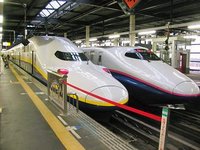
Morioka - Shinkansen trains
© Gelli
Rail is a major form of transport in Japan. Operated by Japan Railways Group, the services are exceedingly efficient, fast and comfortable and almost without exception represent the most convenient option for travellers.
For subways, the price of your ride depends on how far you are going. There will be a map indicating the cost from the current station to all the stations in the system. Carry your city map with you, as it includes an English subway map and could come in handy if the station’s map isn’t in English. When you enter the subway, you put your ticket in the gate and retrieve it. When you exit the subway at your destination, the gate will accept your ticket and keep it. Don’t worry if you didn’t put enough on your ticket. All subway exits will have a place to add additional value to your ticket so you can exit.
There are day passes and stored value cards that could be of value if you are travelling a lot on the subways.
The Japan Rail Pass is a deal devised specifically for visitors to Japan. 7-day, 14-day and 21-day passes will allow unlimited travel on all JR lines and affiliated buses and ferries for the period of the pass. If you planning on travelling by train for even moderate distances, the pass will likely be the cheapest option. The pass is only available to international travellers on a tourist visa and must be purchased overseas. On purchase, you will be issued a Japan Rail Pass Exchange Order, which must be exchanged for a JR Pass at a designated in JR Travel Service Centre in Japan. When you exchange the pass, you need to specify the day you want the period to commence and that day must be within three months of the issue of the Exchange Order.
There are two types of passes. The Ordinary Passes and Green Passes, which allow access to superior Green cars.
Prices for Ordinary Passes are:
- 7-day: ¥28,300 for an adult and ¥14,150 for a child (ages 6-11)
- 14-day: ¥45,100 for an adult and ¥22,550 for a child
- 21-day: ¥57,700 for an adult and ¥28,850 for a child
Prices for Green Passes are:
- 7-day: ¥37,800 for an adult and ¥18,900 for a child
- 14-day: ¥61,200 for an adult and ¥30,600 for a child
- 21-day: ¥79,600 for an adult and ¥39,800 for a child
Source: Japan Rail Pass Types and Prices.
See Also: How it works.
The cost in local currency is calculated when you purchase the Exchange Order.
A list of places where the JR Passes can be purchased can be found on the Japan Rail Pass website.
Several other less expensive passes are also available, covering only specific areas. These passes include:
- The JR East Rail Pass covers Honshu, northeast of Tokyo. It also must be purchased prior to arrival in Japan.
- There are two types of JR West Rail Passes; the Sanyo Area Pass covers the Nozomi Shinkansen and bullet trains from Osaka to Okayama, Hakata and Hiroshima; the Kansai Area Pass includes Osaka, Kyoto, Kobe and Nara. These passes can be purchased from within as well as outside Japan.
- JR Hokkaido offers passes for 3, 5 and 7 days (consecutive) or 4 days (non-consecutive) for the entire Hokkaido area.
- JR Shikoku offers 2, 3, 4 or 5-day passes for travel within Shikoku only.
- JR Kyushu offers 3 or 5-day passes for all Kyushu or just Northern Kyushu.
- Most cities also have special tickets, like the Tokyo Free Kippu, which covers most of the subway lines and JR lines in central Tokyo.
For travellers with an adventurous heart and an empty wallet to match, the Seishun 18 Kippu (Seishun Juhachi Kippu) is a seasonally available railway ticket, which gives you five days of unlimited, nationwide travel on local and rapid JR (Japan Railways) trains. It is a cheap alternative to the Japan Rail Pass and only costs ¥11,500. You have to buy it in a certain period just before the specific travel period. In 2010, the dates for buying and using this pass can be found below.
| March 1 to April 10 | February 20 to March 31 |
| July 20 to September 10 | July 1 to August 31 |
| December 10 to January 20 | December 1 to January 10 |
You cannot use the ticket to travel on any of the fancy bullet trains (shinkansen), or even the most limited express (Tokyo) and express (kyuko) trains, and will instead be limited to the slow, clunky, and constantly stopping local trains (futsudensha/kakuekiteisha) and several rapid JR trains (kaisoku). However, the fact that the travel days are non-consecutive means that you are able to stay in a destination for much longer than the Japan Rail Pass. Travel from Tokyo to Kyoto, stay for a week, then travel back, and you have only used 2 of your 5 days! One could quite feasibly travel from one end of Japan to another on this ticket alone, spending a mere ¥11,500. For the truly impoverished, you can travel at night to save on accommodation too. Also, it can be used by different persons, so for example 5 persons can use it one day. For more information see the Japan Guide.
A useful resource (in English) for finding train timetables, fares and durations is Hyperdia (English).
By Bus
Due to the comprehensive coverage and efficiency of the trains in Japan, long-distance buses are not often considered by visitors to Japan. They are however a cheap alternative for those wanting to save a few pennies. The buses are comfortable and often have on-board toilets, guides and even food and beverage services. Timetables can be found at local information centres. Kakuyasu buses is one of the major operators (partly joined by JR) for intercity bus services.
City buses, while not particularly necessary in the major cities, can be handy in smaller regional centres. Methods of payment vary. One system requires passengers to board at the front and deposit the fare into a slot beside the driver. If you are not sure what the fare is, tell the driver your destination and offer some coins to pick out. Another system requires passengers to board at the centre or back of the bus and take a ticket. A panel at the front indicates which fare is to be paid depending on your destination and this should be paid when you get off the bus.
By Car
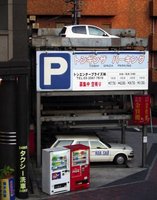
Parking
© Peter
Japan is a relatively safe country to navigate by car if you choose. It is the most flexible way of getting around, if you are in the countryside. Car rental is not necessarily expensive, but road tolls and parking charges can quickly add up. The main problem for visitors is the deciphering of road signs. Also, be sure to drive on the left.
To drive a car in Japan, you will have to have an International Driving Permit. The cost of fuel is comparable to European prices, about double the price in Canada and triple that of US prices. Car parks have had to deal with Japan's lack of space in innovative ways, including stacking the cars with lift systems.
By Boat
There is an extensive network of domestic ferry routes connecting the numerous Japanese islands. Although the main 4 islands are connected by bridges and tunnels, the smaller islands can often only be reached by boat. Also, in some cases, taking the ferry is either a great journey or a decent alternative, for example between Hiroshima and Matsuyama. In some cases the ferry even is you only option of getting to the islands, like some of the more remote of the Okinawa group and the outlying Ogasaware group (Bonin Islands) directly south of Tokyo, from where a 25-hour ferry ride takes you to the main island Chichi-jima. Check the Japan Ferry Travel Guide for maps, routes, schedules and prices.
By Bicycle
Bikes are a popular way to get around in Japan, even in large cities like Tokyo. It is often possible to rent a bicycle in tourist areas. Sidewalks are not off limits to cyclists and often are the preferred place to ride bikes. Just ring the bell to alert pedestrians.
Red Tape
Citizens of most developed countries, including all the usual suspects (US, Canada, UK, EU, etc) can obtain entry permission on arrival without a visa. This is usually valid for a stay of up to 90 days, although Mexicans and some European nationalities are permitted to stay for 180 days if they ask for a longer stay upon entry. All other nationalities must obtain a "temporary visitor" visa prior to arrival, which is generally valid for a stay of 90 days. The Ministry of Foreign Affairs maintains an on-line Guide to Japanese Visas. No visa is required for a same-day transit between international flights at the same airport, so long as you do not leave the secured area.
Foreigners must typically fill out a disembarkation form for immigration, and a declaration form for customs. Those arriving from certain countries may also be required to fill out a quarantine form.
Travellers entering Japan with anything other than a temporary visitor visa are required to obtain a "Residence Card" (在留カード), colloquially known as a gaijin card, within 90 days of arrival and carry it at all times in lieu of their passport. Those staying for 90 days or less may complete this registration, but they are not obligated to. This card must be surrendered upon exit from Japan, unless a re-entry permit is held.
A customs issue that trips up some unwary travellers, is that some over-the-counter medications, notably pseudoephedrine (Actifed, Claritin-D, Sudafed, Vicks inhalers) and codeine (some cough medications), are prohibited to bring into Japan. Some prescription medicines (mostly strong painkillers) are also banned even if you have a prescription unless you specifically apply for permission in advance. You may also require permission in order to import drug-filled syringes, such as EpiPens and the like. Ignorance is not considered an excuse, and you can expect to be jailed and deported if caught. See Japan Customs website for details, or check with the nearest Japanese embassy or consulate. Some items that may not be brought in are actually possible to find locally with restrictions: for example, Benza-Block L, a common cold medicine in Japan, contains pseudoephedrine, with the restriction that one person may only buy one box from one pharmacy at a time.
Once in Japan, you must carry your passport with you at all times. If caught in a random check without it (and nightclub raids are not uncommon), you'll be detained until somebody can fetch it for you. First offenders who apologize are usually let off with a warning, although theoretically you could be fined up to ¥200,000.
All foreigners (except those on government business and certain permanent residents) age 16 and older are electronically fingerprinted and photographed as part of immigration entry procedures. This may be followed by a short interview conducted by the immigration officer. Entry will be denied if any of these procedures are refused.
Money
See also: Money Matters
The Japanese use the Yen (¥).
There are both notes and coins. Most likely, you’ll see ¥1,000, ¥5,000 and ¥10,000 notes. ATMs (see below), mostly give out ¥10,000 notes. Coins come in denominations of ¥500, ¥100, ¥50, ¥10, ¥5 and ¥1. All notes and coins are marked with the denomination of the bill or coin with the exception of the ¥5 coin, which is bronze with a hole in the middle.
ATMs are plentiful, but most are not hooked up to the International networks, meaning that you can’t get money. For international travellers, the best choice is to use the ATMs in 7-11 convenience stores. A second good option is to use the ATMs provided by Japan Post , although some may only be open during post office hours, rather than via an after-hours kiosk. ATMs usually have an English option for instructions.
Credit cards are not widely used. Most hotels take credit cards, although ryokans are mixed, with some smaller places taking cash. Restaurants almost always expect payment in cash, but there are a growing number (usually in the major cities) that will take credit cards. Therefore be prepared to carry lots of cash with you at all times - it is safe, crime is low.
Work
The foreigners who are working in Japan can be lumped into English teachers, not English teachers and United States military. The English teachers are the second largest group and there are several international and domestic agencies that bring English teachers over. The most popular agency is funded by the Japanese government and is called the JET Programme. The Jet Programme has expanded in recent years to include other languages than English, such as French, Spanish, Chinese, Mongolian and Russian, just to name a few. There are several other agencies to place English teachers just be sure to ask around before signing any contract because some can be a bit shady.
Many people come to Japan to work in business. Many of these jobs are in finance, commerce and trading. As one expat says, If you have a Japanese boss you will be expected to work like a Japanese worker. Meaning working extremely long and gruelling hours with little to no time off. It is possible to get business jobs but it helps to know Japanese unless you have lots and lots of experience.
After World War 2, the United States pledged to protect the country of Japan against any future military attack. This means that the United States has approximately 90 military facilities, including several large military bases spread across Japan. As of 2007 there were more than 33,500 US military personal in Japan and also 5,500 civilian employees of the United States Department of Defense. The main bases are on the island of Okinawa, although there are military bases all the way from Hokkaido in the far north to Nagasaki in the far south and everywhere in between. Some of the largest bases right outside of Tokyo and Yokohama. Many foreigners, ex-English teachers and ex-military, have opened bars and restaurants for the US military personnel to spend time at off base.
Working Holiday Programmes
Japan has reciprocal Working Holiday Programmes with Australia, Canada, Denmark, France, Germany, Ireland, New Zealand, South Korea and United Kingdom. Citizens of these countries are eligible to apply for a special type of visa, whereby the applicant may work while in Japan without a sponsor or prior work agreement. The visa is initially valid for 6 months only, but applications for extension for another 6 months is relatively simple, making it effectively a one year working visa. This visa may only be applied for once in a person's lifetime, and is given free of charge.
Once in Japan, working holiday makers may contact the Japan Association for Working Holiday Makers (JAWHM) for free job referral services, accommodation information and opportunities for counseling. JAWHM, a non-profit organisation, is the only non-profit in Japan authorised by the government to help working holiday participates.
Study
Studying in Japan can be a rewarding and great experience. One of the main issues is that study in Japan is a little strange because the better the school, the less the education a foreigner or a local will get. In Japan from lower school to high school students study constantly. From sunrise to sunset they study, study and study. If they get into famous university it is time off! The schools are very hard to get into at the same time almost impossible to fail out. The students party and go crazy for fours years. After finishing school the alumni use the connections they made from their schools to go into the world and make lots of money while at the same time working 70-hour weeks.
Therefore if you are a foreigner looking to learn Japanese, it is best to sign up with a medium level university where the teachers actually teach the students. Also the Japanese students at the medium level schools tend to work harder because they will not have the connections to guarantee a job after graduation. Tuition is very low at Japanese universities but remember the cost of living in Japan is very high.
Language
See also: Japanese Phrasebook
English
Conversational English is not widely spoken. Most Japanese people have knowledge of English because it is studied in junior high and high school. However, it is mostly reading, writing, and grammar that is studied. This means that most people can read and write better than they can speak. Sometimes writing something down may help Japanese people understand better. If it is necessary to ask someone on the street for help, you will have a better chance of being understood if you ask a university aged person because they are more likely to have studied English recently. English is also widely used on signs throughout the country, especially in train stations and subways. A lot of restaurants will have English translations of their menus. The Tourist Information Centers (TICs) will have English speakers, and can help with translations if needed.
Spoken Japanese
Japanese is a phonetic language consisting of 5 vowel sounds (with both a long and short sound) and 16 constant sounds that are combined to make the Japanese alphabet. Japanese pronunciation is easy to learn because each kana character has one sound and only one sound consisting of a vowel and consonant. There are also some kana representing single letter sounds: a, e, i, o, u, and n. This is different from English where every letter can have many pronunciations. However, Japanese grammar is more difficult to learn because the verb comes at the end of the sentence, i.e. subject, object, verb. Whereas English and other Latin based languages are subject, verb, object. For example, when you translate "I bought a shirt" into Japanese, it becomes "I a shirt bought". However, a lot of times in Japanese the subject is not included at all it is generally implied, therefore "I bought a shirt" becomes "bought a shirt".
The Japanese language uses and contains loan words from English, French, German and many other languages. For example the Japanese word for hamburger is hanbagaa, hotel is hoteru, taxi is takushi, bus is basu and beer is biiru. This is useful for travel because a lot of western food uses the same or similar words, but with slightly different pronunciation. However some loan word's definitions were changed when they transitioned to Japanese, e.g. manshun (mansion) means apartment, not a very large house.
Written Japanese
Japanese writing is far more complex. There are three sets of characters, two sets of phonetic kana and one of pictographic kanji. The two types of kana are hiragana and katakana, and each contain 46 syllables. Hiragana is used for most words, whilst katakana is used mainly for foreign words. Kanji is a set of Chinese characters used to represent whole concepts; for example, the word "kitten" is written with two kanji, one meaning "cat" and one meaning "child". There are around 2,000 kanji in common usage. The difference between the three scripts is very obvious: hiragana is curvy and simple, katakana is straight and simple, and kanji is complex. All three sets of characters are intermixed in sentences in paragraphs.
Eat
Though you can easily run up tabs of ¥10,000 (US$ 100) per person in the nicer restaurants, it’s possible to eat really well for a decent price. Decent meals with lots of variety can be found for ¥500 and ¥1,000 (US$5 - US$10) a meal. English isn’t widely spoken, so look for places with English menus or picture menus.
The fish market is a great place to get a cheap breakfast. In most towns there will be a fish market, and since the workers are winding up their day just as you’re getting started, there’s a ton of great sushi and soba noodle places to eat at.
Variety stores have a large selection of prepared meals, from sandwiches (egg salad, tuna, ham and cheese and vegetable are usually all available) to meat skewers and cold noodle dishes.
Also, there is a strong possibility that as you are sitting at the counter, you’ll get invited to join in the conversation, meal and drinks of other parties. Don’t be surprised if they end up paying for your meal - it’s Japanese tradition.
Sleep
Accommodation is very expensive in Japan, but with advanced planning budget travel can be achieved.
Most large cities have a Tourist Information Center (TIC). In most every train station of some size, there will be a Tourist Information Center. Here you will find English speaking staff that can assist you in planning your travels, including booking accommodation. The TICs are hooked into the Welcome Inn Reservation Center, which allows booking of a number of properties across Japan. The TIC can book places using the Welcome Inn Reservation Center.
A Ryokan is a traditional Japanese style inn, where you will find mat floors with a futon and sliding paper doors (though the door to the external hall is a thick metal secure door), and will include a public bath.
The capsule hotel is a cheap alternative as well. The capsule is about 2 metres deep and 1 metre by 1 metre high and wide, just enough to get into and roll around comfortably. The capsule contains a small TV, a radio, an alarm clock and a lamp, all built into the surrounding walls and coated in plastic, making it feel like it could all just be hosed down for cleaning. Basically, the capsule hotel is like a hostel dorm, but for business men in Japan. You share a public bath and will get a small locker, but they will hold a large bag behind the desk. The capsule provides all toiletries needed, including toothbrush and paste, shaver and shaving cream and towels and PJs. No women are allowed at the majority of capsule hotels.
Drink
Like accommodation but unlike food, finding cheap drinks in Japan is tough! There are places that charge as little as ¥300 for a drink, but at many places you’ll be spending ¥600 - ¥1,000 for a pint of beer. It is also legal to walk down the street with alcohol.
If you are in Japan in the summer, for an interesting experience, you need to check out the beer gardens that department stores set up on their roof tops. They often have “all you can drink and eat” specials (timed for 60 or 90 minutes), and provide you with good beer and a do it yourself grill to cook your food.
Health
See also: Travel Health
There are no vaccinations legally required to travel to Japan. It is recommended to have a vaccination against tick borne encephalitis when you go hiking and/or camping for several days or more on the northern islands like Hokkaido in the period of March to November. Only in rare cases is vaccination against Japanese Encephalitis recommended.
Finally, other possible health issues include diarrhea and other general travellers' diseases like motion sickness. Watch what you eat and drink and in case you get it, drink plenty of fluids (to prevent dehydration) and bring ORS.
Japan has one of the best health systems in the world. Not only are the hospitals great and very low costing they are everywhere. Just be prepared for very few English speakers in the hospital itself.
The country itself is very healthy, the food and water is clean and safe to eat or drink anywhere. Japanese people can be extremely paranoid about hygiene to the point that some travellers complain that it can feel a little sterile in Japan. Some people find this a relief after travelling in other Asian countries, such as China or Vietnam, where the hygiene standards are very low. The downside is because of all the hygiene and safety around food the food tends to be very expensive, even in grocery stores or markets.
Injury wise the country is very safe also. All cars, motorbikes and people follow all traffic rules and safety measures to the letter. Travellers can see little kids waiting at every crosswalk looking both ways with their hands up in the air, even if they have the walk symbol. The downside is for travellers used to being in more relaxed countries this might seem like a sign of civilization or just another way to slow you down.
Safety
See also: Travel Safety
Japan has a very low crime rate. In most of the cities, you can see children as young as six catching the trains by themselves, and travel at all times of day and night is considered safe by most. The risk of theft is very low and if you leave a bag behind in a shop, you will just as likely find it still there when you get back, or behind the shopkeepers desk. That said, no nation is perfect, and no doubt unscrupulous people do exist in the larger cities.
However, Japan is quite prone to natural disasters, with earthquakes being the most dangerous of these. While the chance of an earthquake occurring during a visit is extremely low, it may be a good idea to at least familiarize yourself with basic earthquake safety procedures before you leave. Many areas of Japan are prone to tsunamis so if you hear a tsunami warning go behind a safety wall very quickly and learn the local safe spots when you arrive in a tsunami prone town. Volcanic eruptions are possible in Japan but usually there are plenty of warnings so avoid volcanic areas if an evacuation notice has been posted.
Keep Connected
Internet
Manga cafes are dotted along the streets of almost every city in Japan. For a very reasonable price (about ¥100 per 15 minutes), you receive a private cubicle with a PC with internet access at blistering Japanese internet speeds. The chairs are incredibly comfortable (making them an excellent place to sleep for the cash-deprived), and you can even order snacks and drinks from the staff.
A number of business hotels have Internet access available if you have your own device, sometimes for free. It is also possible to find Wi-Fi "hot spots" around many large cities in Japan, especially near tech-related businesses and large corporate buildings with unsecured wireless networks. 3G Wireless Data and Pocket Wifi are other options.
Phone
See also: International Telephone Calls
Payphones (公衆電話 kōshū denwa) are easily found, particularly near train stations, although with the popularity of mobile phones, public pay phones are not quite as numerous as they once were. Gray and green pay phones accept ¥10 and ¥100 coins and prepaid cards. Be aware that not all places with public telephones have phones that accept coins, so it may be worthwhile to buy a phone card for emergency use. Some of the gray phones, as indicated on the display, can make international calls. Pre-paid cards can be purchased at convenience stores, train station kiosk stores and sometimes in vending machines next to the phone.
Modern Japanese mobile phones (携帯電話 keitai denwa or just keitai) tend to operate on unique cellular standards not always compatible with the rest of the world. 3G phones using the UMTS/WCDMA2100 standard and equipped with a 3G SIM card will most likely work. If your phone is up to spec, double-check with your carrier if they have a roaming agreement with either SoftBank or NTT DoCoMo. Coverage is generally excellent, unless you are heading to some remote mountainous areas. If you have no 3G phone but still have a 3G-compatible SIM card, you can rent a 3G phone in Japan and slot in your card, allowing you to keep your home phone number in Japan. For a longer trip, you can also purchase a phone, but doing this legally requires an Alien Registration Card (or an obliging Japanese friend willing to front for you).
The easier way is to get a prepaid phone. Prepaid phones are sold in most SoftBank and AU stores. If you already have a 3G phone, go with Softbank as it can sell SIMs as opposed to au whose prepaid service is phone-based like most CDMA carriers. Prepaid phones use a "card" with a pass key to "charge" a phone with minutes. These prepaid calling cards, unlike the phone itself, can be found in most convenience stores. A prepaid cell phone is available for as little as ¥5000 plus ¥3000 for a 60-90 day call time package, which will get drained at a rate of ¥100 per minute (¥10 per 6 seconds for AU's prepaid service). Both SoftBank and AU offer prepaid phones.
Post
The Japanese postal service is excellent! Domestic and international mail service is very quick and reliable. The prices for sending letters, postcards and parcels vary depending on where you send if from and to which country you send it too, and of course depends on weight as well, so check this calculation page of Japan Post for more details. Post offices generally are open from 9:00am to 5:00pm on weekdays, closing at weekends and also on national holidays, though a few open on Saturdays from 9:00am to 3:00pm. Central post offices are sometimes open until 7:00pm, open on Saturdays from 9:00am to 5:00pm and on Sundays and holidays from 9:00am to 12:30pm. There are post offices in every major city and minor town. Another thing to remember is that the post office is one of the few places in Japan that is guaranteed to have ATMs that take international cards.
References
- 1 April 2008 Estimate. Source: Statistics Bureau of Japan
Contributors
 Utrecht (49%)
Utrecht (49%)
from https://utrecht.travellerspoint.com Lavafalls (16%)
Lavafalls (16%)
from Silver Drops Jewelry Designs
as well as Peter (11%), GregW (5%), agc_cwm (5%), Hien (3%), hasbeen (2%), dr.pepper (2%), PatrickHarnett (1%), robertbaum (1%), zags (1%), cecilecutblues (1%), partyk1d24 (<1%), Tommyboy (<1%), JTBTravel (<1%), charliep (<1%), louwright (<1%), king_golo (<1%), willy360 (<1%), Sander (<1%)
Japan Travel Helpers

SA-Tokyo
Ask SA-Tokyo a question about JapanI'm Japanese & have lived in Tokyo.
So I can help making your travel plan to Japan.
If I have enough time , I can guide around Tokyo to you.
I'm an office worker......so enough time is important.
vkozlova
Ask vkozlova a question about Japanwe are planning to travel to Japan for 2 month in July and August and looking for all helpful tips. What regions the best to visit this time of the year? What is the best way to book reasonably priced accommodations? It any free walking tours in the large cities in english? What is the best way to get to stay in the monastery and get to the not very touristy places?
Any help will be greatly appreciated.
Thank you,
Viktoriya
stevieh
Ask stevieh a question about JapanRyokans instead of hotels. Etiquette.
Hiroshima.
PatrickHarnett
Ask PatrickHarnett a question about JapanDuring the past few years of regular travel to Japan, we have seen and helped many tourists struggling with some of the travel basics, simply because Japan is a very unique country and sometimes presents the unexpected. We have also talked to many people who would love to travel to Japan, but are put off by perceived difficulties with language, transport logistics and thinking it is an expensive country to visit.

VoyageStories
Ask VoyageStories a question about JapanWe spent a month travelling through this beautiful country and can give you tips on how to make every penny go further.
Accommodation in Japan
Explore your accommodation options in Japan
Community Activity
- 6,602 Blog Entries from Japan
- 414 Japan featured photos
This is version 178. Last edited at 23:22 on Dec 10, 19 by willy360. 159 articles link to this page.

Except where otherwise noted, content of this article is licensed under a Creative Commons Attribution-ShareAlike 3.0 License


